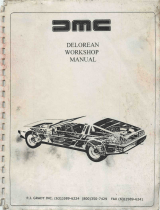Page is loading ...

MPN NO. : 215-435
SAP NO.:187000427
AS-18700-121
REV-A, 2014/12/10
© 2013 Molex
http://www.molexpn.com/
MTS2015-0015
THIS INFORMATION IS CORRECT AS AT THE TIME OF PUBLICATION, SPECIFICATION ARE SUBJECT TO CHANGE SHEET No. 1 of 4
INSTALLATION INSTRUCTIONS
BEFORE INSTALLING OR ADJUSTING THIS PRODUCT,
PLEASE READ THESE INSTRUCTIONS CAREFULLY.
PLEASE KEEP THIS GUIDE FOR FUTURE REFERENCE
MOD-Clip™ UTP Four Pair Termination Tool
1. SCOPE
This document covers the instructions for the proper use and maintenance of the
Four Pair Termination Tool. The tool is designed to terminate 23-24 AWG solid
conductors used to terminate the MOD-Clip™ jacks.
2. COMPONENTS
1) Tool frame
2) Cable termination head
3) Termination head pivot
4) Modclip pusher
5) Handle latch
3. TOOL SET UP
Ensure that the correct lacing head is assembled in the tool frame.
1. For MODCLIP™ jacks the UTP termination head should be used (Refer Fig.3)
IMPORTANT Note: For termination of the C6A MOD-Clip jack use Termination
Tool Frame part no 31.0011. The MOD-Clip Termination frame is not
designed to terminate the MOD-Clip C6A shielded jack
4. FIT THE TERMINATION HEAD.
1. Position the UTP Termination head as shown in fig. 4.
2. Install the two (2) Termination head screws. Avoid damaging the screw by
over-tightening. Not to exceed torque of 1.25N-m (11 inch-pounds)
OPERATION:
CAUTION: Terminate only Molex UTP MOD-Clip jacks with this tool. Do not
terminate other products or hardened objects as damage can occur to the tool.
While squeezing the handles together, pivot the handle latch away from the pin,
and tool handles will spring open.
Order
No.
SAP No.
Description
31.0010
182520001
MODCLIP TERMINATION TOOL FRAME
31.0012
182520003
UTP Termination Head
Fig-4
Fig-1
Fig-2
Fig-3
Fig-4.1

SHEET No. 2 of 4
5. TERMINATION PROCEDURE
Tools Required:
a) Cable Stripper
b) Wire clipper
NOTE: The tool is designed to be used with Molex Premise Networks
branded C5E and C6 U/UTP Cable.
5.1 Cable Preparation
Remove 50mm (2”Inches) of cable
sheath with cable stripper. Cut the
central spline of the UTP cable back to
the sheath. See Fig.5.
5.2. Lacing Wires into the Termination Head.
Pivot the Termination Head 90° so the wire comb grooves face out from the tool.
This is done by pushing the Termination Head to the left and pivoting it until it
locks in place. See Fig.6.
5.2.1 Place the prepared cable end in the slot of the Termination Head. (Fig. 7)
5.2.2. Untwist and lace wires into its respective comb groove in the
Termination Head
Notes:
1. Individual wires must be completely straightened inside the
Lacing head.(Fig. 8)
2. Wires on side of the lacing head can remain twisted
3. There are color code labels on the inside of the tool frame
for reference (Fig. 9)
Jack Wiring Schematic
5.2.3 After all wires have been laced in the Termination Head, place the jack
over the Wires See Fig. 10.
4 CABLE PAIRS TO
BE TERMINATED
CABLE LAID IN
TERMINATION HEAD
Fig-7
Fig-5
Fig-8
Fig-9
Fig-6

SHEET No. 3 of 4
5.2.4 While holding the jack against the wires push the Termination Head to
the left and pivot it 90° into the tool. Start to close the tool handles (Fig.11)
Fully.
NOTE: This tool does not have a full-cycle ratchet action – it is important
for the operator to fully close the tool.
5.2.5 Release the tool handles to open the tool. The jack will remain in the
Termination Head.
5.2.6 Remove the terminated jack by pivoting the Wire Termination Head 90°
and pulling the jack out of the wire comb.
5.2.7 Visually inspect the terminated jack for proper wire termination.
The wires must be cleanly cut and fully seated to the bottom of the slots in the
jack. Fig.12.
5.2.8 Fit cable strain relief stuffer cap (Fig 13)
6. MAINTENANCE
It is recommended that each operator of the tool be made aware of, and
responsible for, the following maintenance steps:
1. Remove dust, moisture, and other contaminants with a clean
brush, or soft, lint free cloth.
2. Do not use any abrasive materials that could damage the tool.
3. Make certain all pins, pivot points, and bearing surfaces are
protected with a thin coat of high machine oil. Do not oil
excessively. The tool is engineered for durability but like any
other equipment it needs cleaning and lubrication for a
maximum service life of trouble free termination.
4. Use light oil (30 weight automotive oil), at all the oil points,
every 5,000 terminations or every 3months. This will significantly
enhance the tool life.(Fig.14)
5. Keep oil away from the Wire Lacing Head and color code
labels. Oil transferred from the wire termination area may affect
the electrical characteristics of the termination or cause color
code labels to fall off.
6. When tool is not in use, keep the handles closed and store the
tool in a clean, dry area
Wires are fully
seated
and cleanly cut
parallel
Fig-12
Fig-10
Fig-13
Fig-11

SHEET No. 4 of 4
Lubrication points (both sides) light oil every 3 months or 5,000
crimps.
7. CAUTIONS
1. Repetitive and prolonged use of this tool can result in repetitive
strain to the user. This tool is intended for standard Structured
Cabling installation use and not high volume OEM factory production.
The insulated rubber handles featured on this tool are not protection
against electrical shock.
2. This tool is intended for use on Molex UTP MOD-Clip jacks only as
specified above.
3. This tool is qualified to insert and cut off wires on the jacks as
described above.
4. When the tool is no longer capable of fully inserting and cutting the
cable, the termination head should be replaced. See replacement
part no’s above.
5. This tool is not designed to be disassembled. Customer repair is
not recommended and is not covered by the warranty
Fig-14
/




